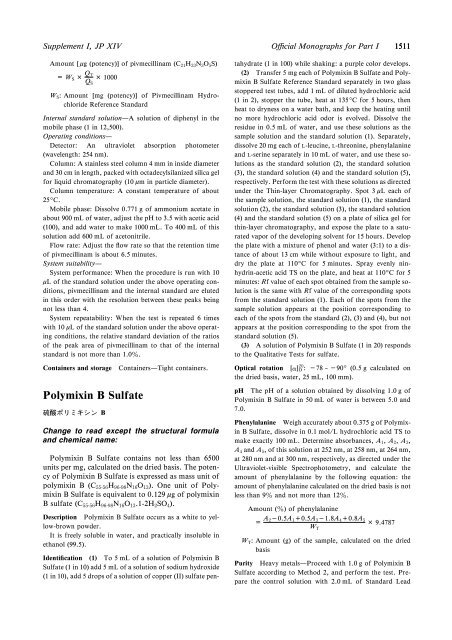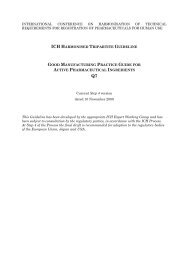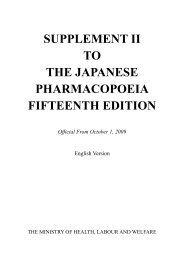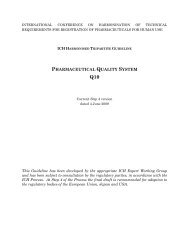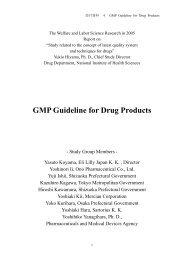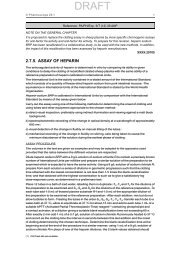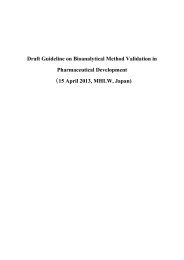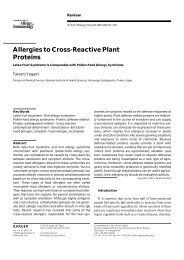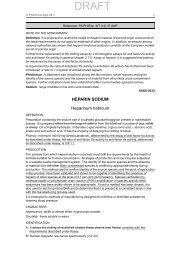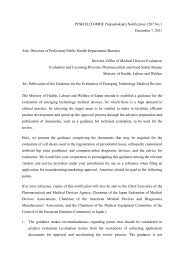Supplement I to the Japanese Pharmacopoeia Fourteenth Edition
Supplement I to the Japanese Pharmacopoeia Fourteenth Edition
Supplement I to the Japanese Pharmacopoeia Fourteenth Edition
Create successful ePaper yourself
Turn your PDF publications into a flip-book with our unique Google optimized e-Paper software.
<strong>Supplement</strong> I, JP XIV<br />
O‹cial Monographs for Part I<br />
1511<br />
Amount [ mg (potency)] of pivmecillinam (C 21 H 33 N 3 O 5 S)<br />
= W S × Q T<br />
Q S<br />
× 1000<br />
W S : Amount [mg (potency)] of Pivmecillinam Hydrochloride<br />
Reference Standard<br />
Internal standard solution—A solution of diphenyl in <strong>the</strong><br />
mobile phase (1 in 12,500).<br />
Operating conditions—<br />
Detec<strong>to</strong>r: An ultraviolet absorption pho<strong>to</strong>meter<br />
(wavelength: 254 nm).<br />
Column: A stainless steel column 4 mm in inside diameter<br />
and 30 cm in length, packed with octadecylsilanized silica gel<br />
for liquid chroma<strong>to</strong>graphy (10 mm in particle diameter).<br />
Column temperature: A constant temperature of about<br />
259C.<br />
Mobile phase: Dissolve 0.771 g of ammonium acetate in<br />
about 900 mL of water, adjust <strong>the</strong> pH <strong>to</strong> 3.5 with acetic acid<br />
(100), and add water <strong>to</strong> make 1000 mL. To 400 mL of this<br />
solution add 600 mL of ace<strong>to</strong>nitrile.<br />
Flow rate: Adjust <strong>the</strong> ‰ow rate so that <strong>the</strong> retention time<br />
of pivmecillinam is about 6.5 minutes.<br />
System suitability—<br />
System performance: When <strong>the</strong> procedure is run with 10<br />
mL of <strong>the</strong> standard solution under <strong>the</strong> above operating conditions,<br />
pivmecillinam and <strong>the</strong> internal standard are eluted<br />
in this order with <strong>the</strong> resolution between <strong>the</strong>se peaks being<br />
not less than 4.<br />
System repeatability: When <strong>the</strong> test is repeated 6 times<br />
with 10 mL of <strong>the</strong> standard solution under <strong>the</strong> above operating<br />
conditions, <strong>the</strong> relative standard deviation of <strong>the</strong> ratios<br />
of <strong>the</strong> peak area of pivmecillinam <strong>to</strong> that of <strong>the</strong> internal<br />
standard is not more than 1.0z.<br />
Identiˆcation (1) To 5 mL of a solution of Polymixin B<br />
Sulfate (1 in 10) add 5 mL of a solution of sodium hydroxide<br />
(1 in 10), add 5 drops of a solution of copper (II) sulfate pentahydrate<br />
(1 in 100) while shaking: a purple color develops.<br />
(2) Transfer 5 mg each of Polymixin B Sulfate and Polymixin<br />
B Sulfate Reference Standard separately in two glass<br />
s<strong>to</strong>ppered test tubes, add 1 mL of diluted hydrochloric acid<br />
(1 in 2), s<strong>to</strong>pper <strong>the</strong> tube, heat at 1359C for 5 hours, <strong>the</strong>n<br />
heat <strong>to</strong> dryness on a water bath, and keep <strong>the</strong> heating until<br />
no more hydrochloric acid odor is evolved. Dissolve <strong>the</strong><br />
residue in 0.5 mL of water, and use <strong>the</strong>se solutions as <strong>the</strong><br />
sample solution and <strong>the</strong> standard solution (1). Separately,<br />
dissolve 20 mg each of L-leucine, L-threonine, phenylalanine<br />
and L-serine separately in 10 mL of water, and use <strong>the</strong>se solutions<br />
as <strong>the</strong> standard solution (2), <strong>the</strong> standard solution<br />
(3), <strong>the</strong> standard solution (4) and <strong>the</strong> standard solution (5),<br />
respectively. Perform <strong>the</strong> test with <strong>the</strong>se solutions as directed<br />
under <strong>the</strong> Thin-layer Chroma<strong>to</strong>graphy. Spot 3 mL eachof<br />
<strong>the</strong> sample solution, <strong>the</strong> standard solution (1), <strong>the</strong> standard<br />
solution (2), <strong>the</strong> standard solution (3), <strong>the</strong> standard solution<br />
(4) and <strong>the</strong> standard solution (5) on a plate of silica gel for<br />
thin-layer chroma<strong>to</strong>graphy, and expose <strong>the</strong> plate <strong>to</strong> a saturated<br />
vapor of <strong>the</strong> developing solvent for 15 hours. Develop<br />
<strong>the</strong> plate with a mixture of phenol and water (3:1) <strong>to</strong> a distance<br />
of about 13 cm while without exposure <strong>to</strong> light, and<br />
dry <strong>the</strong> plate at 1109C for 5 minutes. Spray evenly ninhydrin-acetic<br />
acid TS on <strong>the</strong> plate, and heat at 1109C for5<br />
minutes: Rf value of each spot obtained from <strong>the</strong> sample solution<br />
is <strong>the</strong> same with Rf value of <strong>the</strong> corresponding spots<br />
from <strong>the</strong> standard solution (1). Each of <strong>the</strong> spots from <strong>the</strong><br />
sample solution appears at <strong>the</strong> position corresponding <strong>to</strong><br />
each of <strong>the</strong> spots from <strong>the</strong> standard (2), (3) and (4), but not<br />
appears at <strong>the</strong> position corresponding <strong>to</strong> <strong>the</strong> spot from <strong>the</strong><br />
standard solution (5).<br />
(3) A solution of Polymixin B Sulfate (1 in 20) responds<br />
<strong>to</strong> <strong>the</strong> Qualitative Tests for sulfate.<br />
Containers and s<strong>to</strong>rage<br />
Containers—Tight containers.<br />
Optical rotation [a] 20 D : -78 – -909(0.5 g calculated on<br />
<strong>the</strong> dried basis, water, 25 mL, 100 mm).<br />
Polymixin B Sulfate<br />
硫 酸 ポリミキシン B<br />
Change <strong>to</strong> read except <strong>the</strong> structural formula<br />
and chemical name:<br />
Polymixin B Sulfate contains not less than 6500<br />
units per mg, calculated on <strong>the</strong> dried basis. The potency<br />
of Polymixin B Sulfate is expressed as mass unit of<br />
polymixin B (C 55-56 H 96-98 N 16 O 13 ). One unit of Polymixin<br />
B Sulfate is equivalent <strong>to</strong> 0.129 mg of polymixin<br />
Bsulfate(C 55-56 H 96-98 N 16 O 13 .1-2H 2 SO 4 ).<br />
Description Polymixin B Sulfate occurs as a white <strong>to</strong> yellow-brown<br />
powder.<br />
It is freely soluble in water, and practically insoluble in<br />
ethanol (99.5).<br />
pH The pH of a solution obtained by dissolving 1.0 g of<br />
Polymixin B Sulfate in 50 mL of water is between 5.0 and<br />
7.0.<br />
Phenylalanine Weigh accurately about 0.375 g of Polymixin<br />
B Sulfate, dissolve in 0.1 mol/L hydrochloric acid TS <strong>to</strong><br />
make exactly 100 mL. Determine absorbances, A 1 , A 2 , A 3 ,<br />
A 4 and A 5 ,ofthissolutionat252nm,at258nm,at264nm,<br />
at 280 nm and at 300 nm, respectively, as directed under <strong>the</strong><br />
Ultraviolet-visible Spectropho<strong>to</strong>metry, and calculate <strong>the</strong><br />
amount of phenylalanine by <strong>the</strong> following equation: <strong>the</strong><br />
amount of phenylalanine calculated on <strong>the</strong> dried basis is not<br />
less than 9z and not more than 12z.<br />
Amount (z) of phenylalanine<br />
= A 2-0.5A 1 +0.5A 3 -1.8A 4 +0.8A 5<br />
W T<br />
× 9.4787<br />
W T : Amount (g) of <strong>the</strong> sample, calculated on <strong>the</strong> dried<br />
basis<br />
Purity Heavy metals—Proceed with 1.0 g of Polymixin B<br />
Sulfate according <strong>to</strong> Method 2, and perform <strong>the</strong> test. Prepare<br />
<strong>the</strong> control solution with 2.0 mL of Standard Lead


